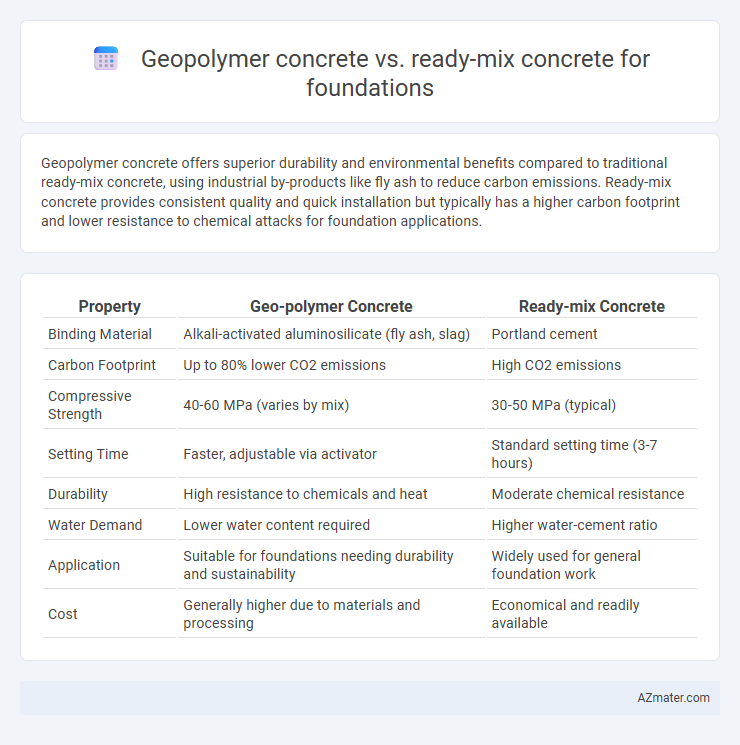Geopolymer concrete offers superior durability and environmental benefits compared to traditional ready-mix concrete, using industrial by-products like fly ash to reduce carbon emissions. Ready-mix concrete provides consistent quality and quick installation but typically has a higher carbon footprint and lower resistance to chemical attacks for foundation applications.
Table of Comparison
| Property | Geo-polymer Concrete | Ready-mix Concrete |
|---|---|---|
| Binding Material | Alkali-activated aluminosilicate (fly ash, slag) | Portland cement |
| Carbon Footprint | Up to 80% lower CO2 emissions | High CO2 emissions |
| Compressive Strength | 40-60 MPa (varies by mix) | 30-50 MPa (typical) |
| Setting Time | Faster, adjustable via activator | Standard setting time (3-7 hours) |
| Durability | High resistance to chemicals and heat | Moderate chemical resistance |
| Water Demand | Lower water content required | Higher water-cement ratio |
| Application | Suitable for foundations needing durability and sustainability | Widely used for general foundation work |
| Cost | Generally higher due to materials and processing | Economical and readily available |
Introduction to Geo-polymer and Ready-mix Concrete
Geo-polymer concrete is an eco-friendly alternative to traditional concrete, utilizing industrial by-products like fly ash or slag combined with alkaline activators to create a strong, durable material with significantly lower carbon emissions. Ready-mix concrete is a pre-mixed, factory-produced concrete designed for immediate use, ensuring consistent quality and saving time in construction projects. Both materials serve as foundational options, but geo-polymer concrete emphasizes sustainability and chemical bonding, while ready-mix concrete prioritizes convenience and uniformity.
Composition and Material Differences
Geopolymer concrete for foundations uses industrial by-products like fly ash or slag activated with alkaline solutions, eliminating the need for traditional Portland cement and reducing carbon emissions. Ready-mix concrete relies on a blend of cement, water, sand, and aggregates, chemically hydrated to gain strength through cementitious compounds. The material composition of geopolymer concrete enhances chemical resistance and durability, while ready-mix concrete offers consistent workability and well-established structural performance in foundation applications.
Strength and Durability Comparison
Geo-polymer concrete exhibits higher compressive strength and enhanced chemical resistance compared to traditional ready-mix concrete, making it more suitable for foundations exposed to aggressive environments. Its reduced permeability and superior resistance to sulfate and chloride attacks contribute significantly to long-term durability. Ready-mix concrete, while widely used, often requires additional admixtures to achieve comparable durability and may demonstrate lower strength retention under harsh conditions.
Environmental Impact and Sustainability
Geo-polymer concrete significantly reduces carbon emissions by utilizing industrial by-products such as fly ash and slag, offering a sustainable alternative to traditional ready-mix concrete whose production relies heavily on cement, a major CO2 emitter. The lower energy consumption and reduced greenhouse gas footprint associated with geo-polymer concrete enhance its environmental benefits, especially in foundation construction where large concrete volumes are used. Despite similar structural performance, the sustainability profile of geo-polymer concrete promotes eco-friendly construction practices and supports green building certifications more effectively than conventional ready-mix concrete.
Setting Time and Workability
Geopolymer concrete exhibits a faster setting time compared to traditional ready-mix concrete due to its chemical composition, which enhances early strength development critical for foundation stability. Workability in geopolymer concrete can vary based on the type and proportion of activators used, often requiring careful mix design to achieve similar fluidity to ready-mix concrete. Ready-mix concrete offers more consistent workability through controlled water content and admixtures, making it easier to handle and place, although its setting time is generally longer, which may delay construction schedules.
Cost Analysis and Economic Considerations
Geo-polymer concrete offers significant cost savings over ready-mix concrete for foundations due to its use of industrial by-products like fly ash, reducing raw material expenses and minimizing environmental fees. The durability and reduced maintenance requirements of geo-polymer concrete further enhance its long-term economic benefits, while ready-mix concrete often incurs higher costs from cement production and frequent repairs. Life cycle cost analysis reveals geo-polymer concrete as a more sustainable and economical option, particularly in regions with abundant fly ash and strict emission regulations.
Performance in Foundation Applications
Geopolymer concrete exhibits superior chemical resistance, higher thermal stability, and improved durability compared to ready-mix concrete, making it ideal for foundation applications exposed to aggressive environments or extreme temperatures. Ready-mix concrete offers dependable compressive strength and ease of placement, but may be susceptible to sulfate attack and carbonation over time. In foundation applications, geopolymer concrete ensures enhanced longevity and reduced maintenance costs due to its superior bonding and reduced permeability.
Construction Process and Ease of Use
Geo-polymer concrete for foundations involves a specialized mixing process using industrial by-products like fly ash and alkaline activators, requiring precise control of chemical ratios to ensure proper curing and strength development. Ready-mix concrete offers a streamlined construction process with pre-mixed, standardized batches delivered directly to the site, enabling faster placement and reduced labor. Ease of use favors ready-mix concrete due to its consistency, immediate availability, and compatibility with traditional concrete pouring equipment, while geo-polymer concrete demands skilled handling and careful onsite mixing to optimize performance.
Long-term Maintenance and Lifespan
Geopolymer concrete exhibits superior durability and chemical resistance compared to ready-mix concrete, significantly reducing long-term maintenance costs and extending foundation lifespan, particularly in harsh environmental conditions. The reduced permeability and enhanced resistance to sulfate attack in geopolymer concrete contribute to its resilience against cracking and degradation over decades. In contrast, ready-mix concrete foundations often require more frequent repairs and protective treatments due to susceptibility to corrosion and freeze-thaw damage, leading to higher maintenance efforts over time.
Recommendations for Foundation Selection
Geo-polymer concrete offers enhanced durability, chemical resistance, and reduced environmental impact, making it ideal for foundations in aggressive soil conditions or marine environments. Ready-mix concrete provides consistent quality and faster placement, suitable for standard foundation projects requiring reliable compressive strength and cost efficiency. Selection should consider site-specific factors like exposure conditions, load requirements, and sustainability goals to optimize foundation performance.

Infographic: Geo-polymer concrete vs Ready-mix concrete for Foundation
 azmater.com
azmater.com